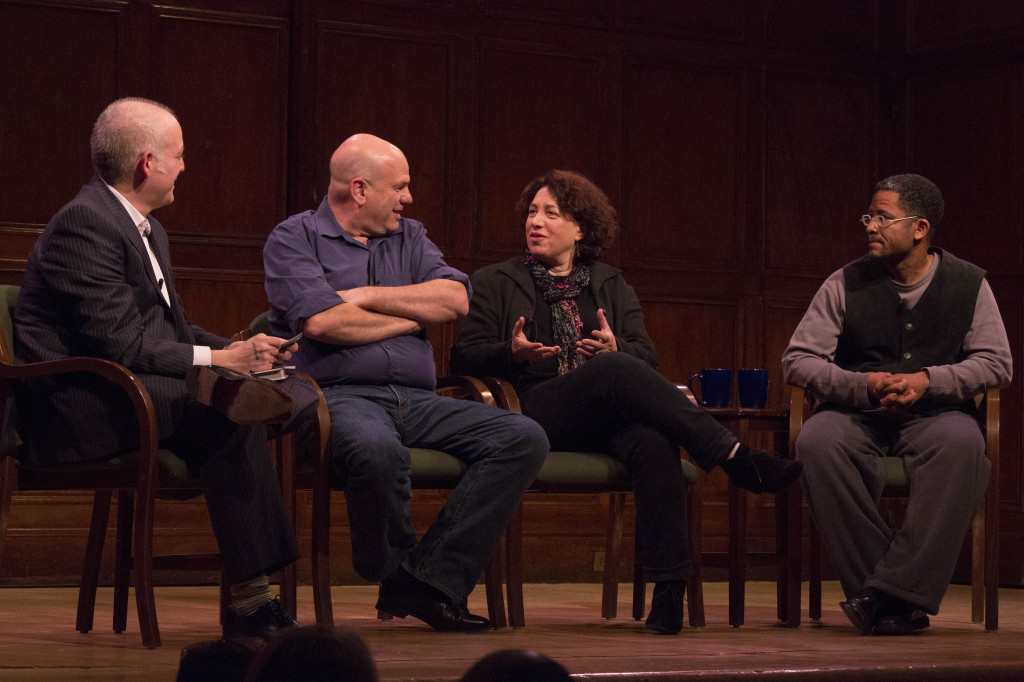Review: The Minds Behind HBO’s Award-Winning ‘Treme’ Chat at 92Y
by Kaitlin Ahern
Five years after Hurricane Katrina, HBO premiered Treme, a documentary-style drama that follows several New Orleanians as they try to rebuild their community and careers. The show’s co-creator, executive producer and story editor stopped by 92Y to talk about the final season and introduce Treme: The Cookbook.

From left: Moderator Matt Zoller Seitz, a Brooklyn-based writer and TV critic for New York magazine; David Simon, award-winning co-creator and executive producer of Treme; Nina K. Noble, a New York-native and executive producer of the show; Lolis Eric Elie, award-winning staff writer and story editor for the show and author of the Treme cookbook. Joyce Culver
Following one of the worst natural disasters in the history of the United States, when 2005’s Hurricane Katrina swept through New Orleans taking thousands of lives, homes and businesses with it, the city struggled to regain its footing and, most importantly, preserve its unique culture.
Now in its fourth and final season, the Peabody Award-winning show Treme centers around major themes of music, food and politics and how these areas of New Orleans culture have been affected in the aftermath of Katrina. It was the city’s food, specifically, that took the spotlight Dec. 13 at the 92nd Street Y, when the venue’s 92Y Talks series presented a panel discussion and recipe tastings from the new cookbook based on the TV show, Treme: Stories and Recipes from the Heart of New Orleans.
With more than 100 heritage and contemporary recipes accompanied by photographs from the critically-acclaimed series, Treme, the cookbook, is a celebration of the eclectic and inventive culinary spirit of post-Katrina New Orleans, including contributions from such legendary restaurants as Brigtsen’s, Upperline and Commander’s Palace, plus original recipes from many of the renowned chefs who have made guest appearances on the show.
A Taste of New Orleans in New York City
The tastings presented at the 92nd Street Y included a classic red beans and rice dish, a rich pound cake dotted with chocolate chips and walnuts, and two Southern-style cocktails, one featuring cognac and the other a cucumber gin.
After audience members had engaged their palettes, the lights dimmed for a panel discussion about food’s role on Treme featuring David Simon, award-winning co-creator and executive producer; Lolis Eric Elie, award-winning staff writer and story editor for the show and author of the Treme cookbook; and Nina K. Noble, a New York-native and executive producer of the show. Brooklyn-based writer Matt Zoller Seitz, known as the TV critic for New York magazine, served as moderator.
Getting the Food Just Right
The group talked about the challenge of choreographing food into the show, especially during kitchen scenes. The show has been filmed mostly in real kitchens instead of on sets, with actors and non-actors working together.
“There’s a whole dance that people who work in kitchens know,” Noble said. “We have to think about realism and about the scene—it all has to work together.”
The panel also addressed the pride New Orleanians have in their culture and heritage, and how that shines through in the food they make.
“There’s a certain self-awareness in New Orleans,” said Simon, who hails from Baltimore. “Before Katrina, 71 percent of the population was native, and they took a lot of pride in that. New York, on the other hand, is a city of immigrants, and not everything is staked on what your grandmother put in her gumbo.”
Elie, a New Orleans native, added: “Every boy in New Orleans is honor bound to say his mother makes the best gumbo—of course, I’m the one telling the truth.”
The recipe for Elie’s mother’s gumbo appears in the Treme cookbook, as do memorable recipes from the show such as chef Janette Desautel’s Crawfish Ravioli and LaDonna Batiste-Williams’s Smothered Turnip Soup. (When asked later on in the evening what he left out of his mother’s gumbo recipe, Elie admitted that he omitted her signature garlic bologna.)
Most of the dishes qualify as New Orleans comfort food, which is something many residents of the city turned to after Katrina. The idea of picking up and carrying on after trauma is an important part of the show, and food in the New Orleans culture carries a comfort that helps to ease that trauma a bit. After the storm, Elie said, he and friends got together and served red beans and rice. “What other city could you serve a dish and say ‘This is our food,’” he said. “That’s why food is so central to the show.”
In the third season of the show, one of the main characters, chef Janette Desautel, comes to New York seeking a better career and works through three Manhattan kitchens. Two of the kitchens are “fake” (built specifically for the show), but one of them is the three-Michelin-starred Le Bernardin. The crew shot in the actual Le Bernardin kitchen with the actual restaurant crew, who came in on Sundays (their only day off) to film.
After the panel discussion, the three speakers took several questions from the audience. One audience member asked if they thought New Orleans will lose its culture in the aftermath of Katrina.
“We’ve already started seeing and tasting new cultures,” Simon said. “Things will change because things will always change. There are a lot of new people in New Orleans after the storm, but it’s a good thing for the culture to evolve.”
